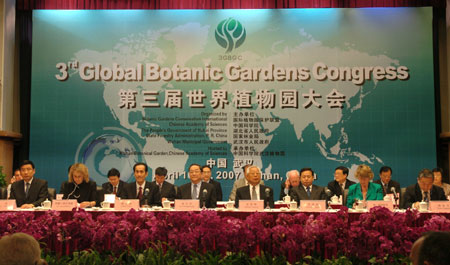| Home / Environment / International Cooperation | Tools: Save | Print | E-mail | Most Read |
| World's Botanists Meet to Discuss Plant Conservation |
| Adjust font size: |
About 1,000 botanists and horticulturists from around the world gathered in the central Chinese city of Wuhan on Monday to discuss ways to conserve global plant diversity. "Of the current 300,000 to 450,000 plant species in the wild, 10 percent to 20 percent are threatened or faced with extinction according to our most conservative calculation," said Sara Oldfield, secretary general of the UK-based Botanical Gardens Conservation International (BGCI), at the Third Global Botanical Gardens Congress.
But the number of endangered species may actually be as high as 94,052 to 193,513 and if mankind does not take emergency measures, we could witness a complete exhaustion of plant resources by the end of this century, she said. It is the first time the congress has been held in Asia, attracting 726 botanists and horticulturists from 89 countries and regions in addition to 252 Chinese experts. During the five-day congress, between April 16 and 20, the experts will discuss how to achieve a sustainable future through the role of botanical gardens. BGCI, a charity group and also a company registered in England, links more than 800 botanical gardens and botanical institutions in more than 120 countries and regions. Data provided by Chinese botanical gardens will become an important part of a global database of every plant species in the world, now under construction, said Professor Peter H. Raven, president of the Missouri Botanical Garden. "If a national network of botanical gardens can be established in China, it will improve conservation of the country's plants," said Raven. Raven said the BGCI hoped to complete the database within six years but meeting this target would depend on support from countries all round the world, especially those with large biodiversities such as China. China has more than 31,000 species of plants, the third largest number of varieties in the world after Brazil and Columbia, but about 6,000 are endangered, according to statistics from the World Conservation Union. "About 200 botanical gardens have been built in China, but only 40 of them are focusing on plant conservation and scientific research," said Huang Hongwen, director of the Wuhan Botanical Gardens. "The rest of them cater for tourists and school trips." Huang has submitted a proposal to the Chinese Academy of Sciences (CAS) and other government departments suggesting the country's botanical gardens should be organized into a national network so they can collect and share data from plants in their own areas. He said that 30 botanical gardens should be selected as the key members of the network and they should take the lead to try and reach international standards. "This will improve the research capability of botanical gardens across the country and help establish a reliable national database which can be integrated into the global database," said Huang. "China is taking an active role in plant conservation and the construction of botanical gardens," said Sara Oldfield, Secretary-General of the BGCI. She said that with a unified national network of botanical gardens, China would be able to contribute more to the protection of the world's biodiversity.
At the BGCI congress, the State Forestry Administration (SFA) released the National Strategy for Plant Conservation to complement the Global Strategy for Plant Conservation. The role of botanical gardens is highlighted in this program as well as their role in collaborating with foreign counterparts and international organizations, said Dr Jia Jiansheng, deputy director-general of the Department of Wildlife Conservation of the SFA. (Xinhua News Agency April 17, 2007) |
| Tools: Save | Print | E-mail | Most Read |
 |
| Related Stories |
|
||||

